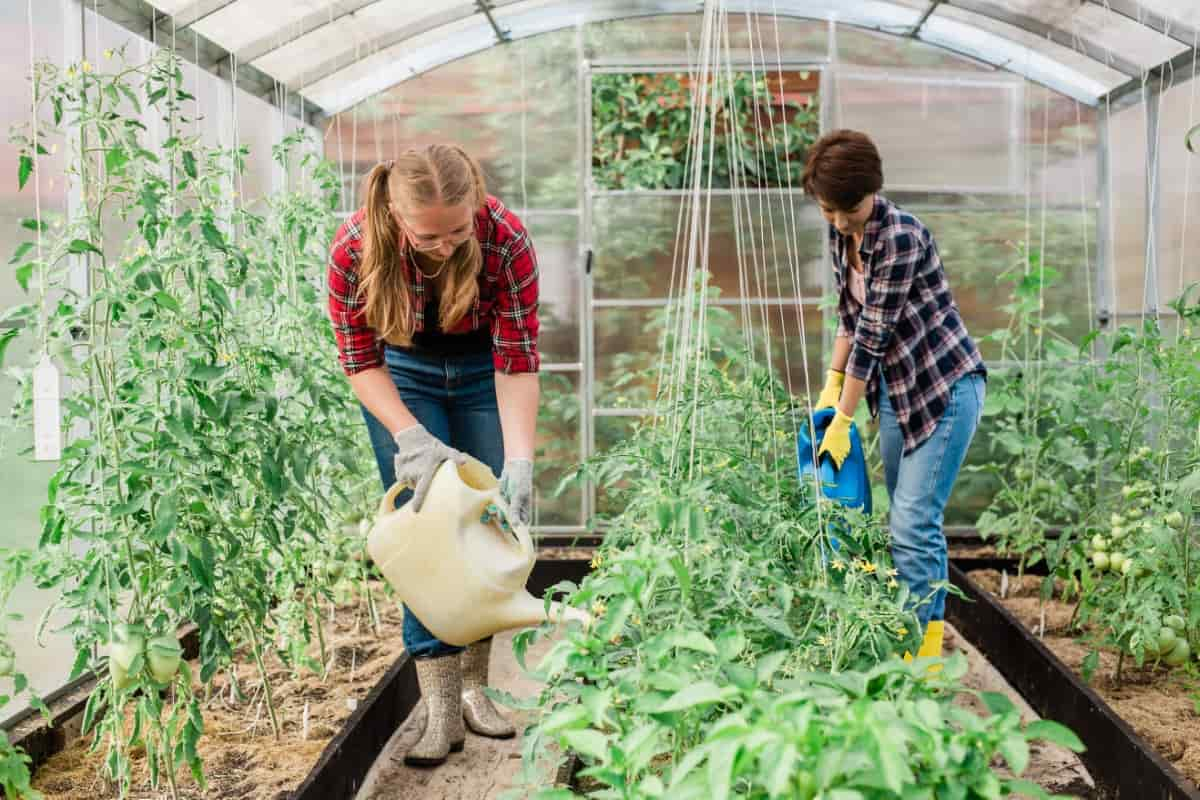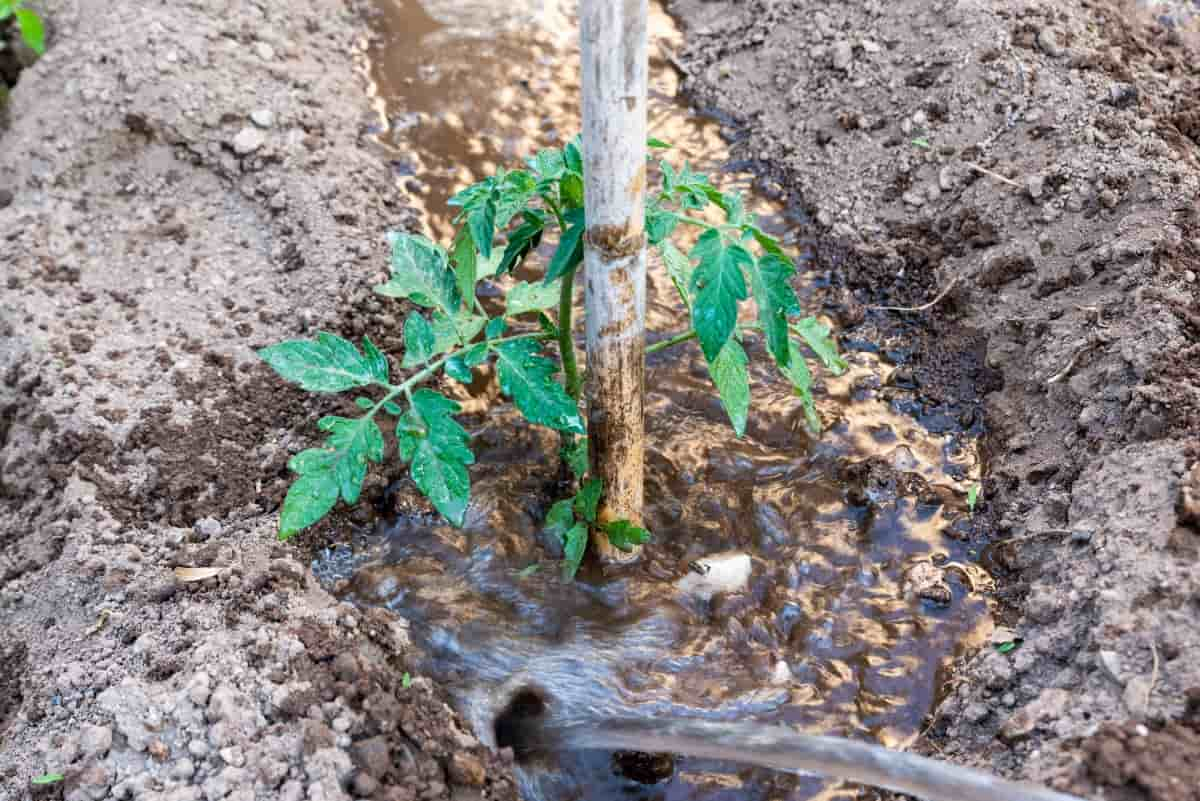Tomato plants, scientifically known as Solanum lycopersicum, are members of the nightshade family and belong to the vegetable category. Overwatering makes the Tomato leaves and branches wilt and droop; these are the main signs of overwatered Tomato plants. Overwatered Tomato plants display wilting leaves and drooping branches due to excessive moisture in the soil.

Overwater Tomato Plants
Understanding the Signs of Overwatering in Tomato Plants
The excess moisture causes the roots to become waterlogged, inhibiting their ability to absorb nutrients properly. So how do you know if your Tomato plants are being overwatered? Well, one of the first signs is wilting leaves. Instead of standing tall and proud, the leaves may droop and look limp. Excessive watering disrupts the plant’s cells’ balance between air and water. Another indicator is yellowing or browning leaves.
When there’s too much moisture around the roots, it can lead to root rot, which manifests as discolored foliage. Additionally, Overwatering Tomatoes can cause stunted growth and poor fruit production. Another sign of overwatering is drooping branches. Like wilting leaves, the roots struggle due to excessive moisture levels in the soil. Yellowing or browning of lower leaves is yet another signal that your Tomatoes are getting too much water.
Identifying the Effects of Excessive Watering on Tomato Plants
One of the first signs of excessive watering is wilting leaves. When Tomato plants receive too much water, the plant roots become saturated, leading to a lack of oxygen uptake. This causes the leaves to droop and appear wilted, even though the soil may be moist. Another effect of overwatering is the yellowing or browning of the lower leaves.
Excess water can lead to nutrient leaching from the soil, depriving the plant of essential elements like nitrogen and causing deficiencies. This results in discoloration and weakening of the lower foliage. Overwatered Tomato plants are susceptible to fungal infections. Furthermore, excessive watering can hinder fruit production. Overly wet conditions can interfere with pollination by preventing bees and other pollinators from visiting flowers. This leads to a decrease in fruit set and ultimately affects yield.
How to Diagnose Overwatering in Tomato Plants: Key Indicators to Look for
One of the key indicators to look for when diagnosing overwatering in Tomato plants is wilting leaves. While it may seem counterintuitive, overwatered plants often display signs of dehydration due to excessive moisture leading to root rot and nutrient deficiencies. Another important indicator is drooping branches, which can occur due to waterlogged soil lacking oxygen. The roots cannot properly absorb nutrients and water, causing the plant’s overall health and growth to suffer.
In case you missed it: Natural Ways to Get Rid of Tiny Bugs on Tomato Plants: Aphids on Tomatoes, Control with Home Remedies

When Tomato plants are overwatered, their root systems become weak and shallow, inhibiting their ability to take up essential nutrients from the soil and limiting their potential for healthy development. Mold or fungal growth on the soil’s surface or around the plant’s base may indicate excessive moisture levels. These conditions create an ideal environment for pathogens that thrive in damp conditions.
The Impact of Overwatering on Tomato Plant Health and Growth
Overwatering can significantly impact the health and growth of Tomato plants. When plants are overwatered, their roots become saturated with water, leading to a lack of oxygen in the soil. This lack of oxygen prevents proper nutrient absorption and can result in stunted growth. Additionally, overwatering can create an ideal environment for fungal diseases. These diseases thrive in wet conditions and can quickly spread throughout the plant if not addressed promptly. These diseases further weaken the plant’s health and reduce its ability to produce healthy fruits.
Preventing Overwatering in Tomato Plants: Best Practices and Techniques
Establish a watering schedule that allows the soil to dry out slightly between waterings. This will help avoid saturated roots and promote healthy root development. How to fix overwatered Tomato plants? Check the soil moisture level before watering. Furthermore, consider using mulch around your Tomato plants.
In addition, make sure you use a well-draining soil mix when planting Tomatoes. Sandy loam or loamy soils work best, allowing excess water to drain away. Consider utilizing drip irrigation systems instead of overhead sprinklers. These methods deliver targeted water directly to the root zone without wetting foliage unnecessarily.
Effective Treatment Methods for Overwatered Tomato Plants
The first step in treating these plants is to stop watering them immediately. To expedite the drying process, gently loosen the top layer of soil around the plant’s base. This will help facilitate evaporation and prevent water from pooling around the roots. Overwatering Tomato plants in pots also affects plant growth. Additionally, providing adequate drainage for your Tomato plants is crucial.
In case you missed it: How to Grow Black Krim Tomatoes: A Guide to Planting, Care, and Harvest

Ensure that pots or containers have proper drainage holes, and if planting directly in the ground, consider adding organic matter to improve soil aeration. Another effective treatment method for overwatered Tomato plants involves improving air circulation around the foliage. Prune any yellowing or damaged leaves, which can contribute to excess moisture retention. Monitoring future watering habits is essential in preventing overwatering issues in Tomato plants.
Restoring Health to Overwatered Tomato Plants: Step-By-Step Guide
- Assess the damage: Start by examining your plants closely. Look for wilting leaves and drooping branches, as these are clear indicators of overwatering.
- Ensure proper drainage: Ensure your pots or planting beds have adequate drainage holes to prevent water from pooling around the roots.
- Stop watering: One of the first steps in restoring overwatered Tomato plants is to stop watering them altogether. This allows the soil to dry out and gives the roots a chance to recover.
- Adjust watering schedule: Once the soil has dried out, gradually reintroduce water in smaller amounts and less frequently.
- Trim-damaged foliage: Prune any yellow or brown leaves and branches affected by overwatering.
- Provide support: If necessary, use stakes or cages to support weakened stems after pruning.
Adjusting Watering Habits to Avoid Overwatering in Tomato Plants
Proper watering of the plant is essential for the health and vitality of Tomato plants. Adjusting your watering habits accordingly is crucial to avoid this common mistake. You need to establish a watering schedule that aligns with the needs of your specific Tomato plants. This may vary depending on factors such as soil type and the size of your plants. It’s important not to water on a fixed schedule but rather observe the moisture levels in the soil before deciding when to water next.
Another helpful technique is using a drip irrigation system or soaker hoses instead of overhead sprinklers. These methods deliver water directly at ground level without wetting the foliage excessively, reducing the risk of foliar diseases caused by excess moisture. Adjust accordingly; if you notice signs of overwatering Tomato plants, such as yellowed leaves or root rot, reduce frequency or duration until balance is restored.
Common Mistakes in Watering Tomato Plants: Tips for Avoidance
One of the most common mistakes gardeners make when watering Tomato plants is overdoing it. It’s easy to think that more water equals better growth, but excessive watering can harm your Tomato plants. One mistake to avoid is giving your Tomato plants a daily drenching. While Tomatoes need consistent moisture, they also require periods of dryness between waterings.
Another mistake is using improper watering techniques. Many gardeners pour water directly onto the plant foliage, which can increase the risk of disease and sunburned leaves. Instead, focus on water at the base of the plant near the soil level. This ensures that the roots receive adequate hydration without unnecessary wetting of the leaves. Tomato plants thrive in well-drained soil conditions; planting them in heavy clay soils or containers without proper drainage holes can lead to excess moisture retention around their roots.
Maintaining Proper Soil Moisture Levels for Healthy Tomato Plants
To maintain proper soil moisture, start by checking the moisture level regularly. Stick your finger into the soil to see if the soil feels dry or moist. If it’s dry, it’s time to water the plant; if it’s moist, hold off on watering. Water deeply but infrequently. This encourages deeper root growth and prevents surface evaporation.
In case you missed it: Tomato Plants Look Healthy but No Flowers: Reasons, How to Fix, Remedies, and Solutions

Consider mulching around your Tomato plants; it helps retain soil moisture by regulating temperature fluctuations. Remember that different stages of growth may require different amounts of water. Young seedlings need less water than established plants with larger root systems.
Conclusion
Overwatering can harm Tomato plants, causing their leaves and branches to wilt and droop. These visible signs indicate that the plant is receiving too much water. One of the first indicators of overwatering in Tomatoes is wilting leaves. With their versatile nature and widespread popularity, Tomato plants can be grown indoors and outdoors. They require well-drained soil rich in organic matter and thrive in full sun exposure. Proper care includes regular watering, pruning to promote airflow, and supporting such as stakes or trellises for climbing the vines.
- Feed Your Flock for Less: Top 10 Tips to Save on Chicken Feed
- Ultimate Guide to Ossabaw Island Hog: Breeding, Raising, Diet, and Care
- Hatching Answers: The Top 10 Reasons Your Chickens Aren’t Laying Eggs
- Eggs and Economics: Breaking Down the Cost of Raising Backyard Chickens
- Defend Your Greens: Proven Methods to Keep Iguanas Out of Your Garden
- Ultimate Guide to Cinnamon Queen Chicken: A Comprehensive Guide for Beginners
- Ultimate Guide to California Tan Chicken: Breeding, Raising, Diet, Egg-Production and Care
- Ultimate Guide to Marsh Daisy Chicken: Breeding, Raising, Diet, and Care
- 10 Types of Chicken Farming Businesses You Can Start for Profits